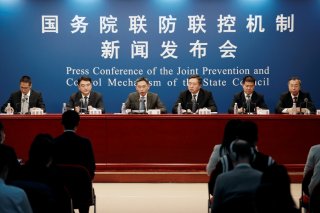by William Wang Holly Snape
Source Link

Hundreds of people have been queueing in the city of Yiwu in eastern China in recent days to get an experimental vaccine for COVID-19. Although the vaccine is yet to complete its clinical trials, it was reportedly given to hundreds of thousands of people in the past few months, and is now being offered under an emergency use licence to the general public.
Around the world, as first waves pass and new waves close in, a coronavirus vaccine has become a focus of hope. For China, quick progress on the vaccine is a matter of both domestic and international politics.
In early October, the Chinese government announced it would join the WHO Covax initiative for global cooperation on developing, producing and distributing a vaccine.
This was not simply a public relations move in a game of one-upmanship with the US – which refused to join Covax. Instead, it forms part of the Chinese authorities’ overall approach to the vaccine, which is informed by the need to tread a path between managing international tensions and presenting the strength of the Chinese Communist Party (CCP)-led system domestically.
Despite a new flare-up of COVID-19 in the eastern port city of Qingdao, China’s official line is that the country has already achieved “strategic success” in beating the virus. There is some truth to that. China’s proactive, stringent control measures have received significant praise, including from the World Health Organization (WHO). And yet, suspicion and doubt remain over the early days of China’s response to the epidemic.
From a public administration perspective, Chinese authorities have been taking action toward developing a vaccine since the start of the epidemic. In January, they set up a top-level response task force which, among its at least seven internal groups, included a Research Front Team that brought together at least 12 ministries and departments. Vaccine research and development was among the team’s key assignments.
Our own ongoing research, which has been systematically collecting and analysing Chinese government and CCP policies responding to COVID-19, found that the Research Front Team was among one of the few internal groups which actively made policy documents publicly available. From the start of China’s response, the vaccine was visibly high on the agenda.
In August, China’s National Medical Products Administration issued five policy documents highlighting concrete principles and standards for vaccine development. This was another display of the speed of public administrators in pushing ahead with a vaccine by addressing the need for a balance between acting fast and ensuring scientific ethical standards.
‘Full victory’ hangs on a vaccine
From a political perspective, China’s vaccine progress has both domestic and international dimensions. The CCP’s official line is that it has made “major strategic achievements” against COVID-19 – a term used consistently across official Chinese communications. A vaccine would top off this triumph.
This clear message of success is combined with a discursive technique commonly adopted by the CCP: time-based cognitive framing, in which periods or points in time are used to develop a favourable narrative while smoothing away inconvenient details.
At a ceremony in September to commend people who had contributed to the pandemic response, CCP general secretary, Xi Jinping, set out milestones that form the contours of the official account. He said China took: “One month or so to initially contain (the virus) … around two months to keep new daily domestic cases within single digits,” and “about three months to achieve decisive gains in the battle for Wuhan and Hubei.”
China has left the emergency phase of its response and entered a “normalising prevention and control” phase. At events such as the commendation ceremony and an exhibition in October organised by the CCP Propaganda Department, this shift in phases is portrayed as evidence of the “strength” of the Chinese system. Logically, the vaccine is the next step.
Drowning out critics
Such domestic policy and political considerations are tied up with international ones. The Trump administration has promoted a sharp change in US policy toward China and rejected elements of the current global governance system, including the WHO. Meanwhile, despite an ongoing inquiry by the WHO into the global response to the pandemic, some countries including Australia continue to call for an independent investigation into the origins of COVID-19, keeping the spotlight on China.
Faced with this challenge, the CCP seems to be trying to drown out rather than engage with difficult discussions. The vaccine is a useful theme to focus on while squeezing out room to discuss China’s initial response.
The US rejection of the WHO’s attempts at international vaccine cooperation offers the CCP a valuable source of rhetorical righteousness. It can use loud platitudes about China’s support for the current institutions of global governance and back up its claims with money and technology. By focusing on its willingness to cooperate on a vaccine, the CCP gains twofold. It can shield itself from accusations of culpability – and win praise for its global-spiritedness for being willing to step up, contribute and collaborate internationally while the US refuses to do so.
The CCP is all too aware that as the pandemic continues, it sits at the crux of potential controversy – all while international animosity towards China grows. Instead of seeking to lock horns with views that challenge its narrative, it is trying to remain entirely aloof from them and focus squarely on projecting an image of international cooperation.
No comments:
Post a Comment